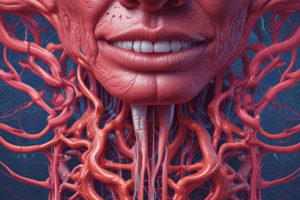Podcast
Questions and Answers
What percentage of an adult's body does the skin cover?
What percentage of an adult's body does the skin cover?
16%
What are the three main functions of the skin?
What are the three main functions of the skin?
Protection, regulation, and sensation
What is the name of the cells responsible for touch sensation on the skin's surface?
What is the name of the cells responsible for touch sensation on the skin's surface?
Merkel cells
What is the oily substance produced by microorganisms living on the skin?
What is the oily substance produced by microorganisms living on the skin?
What is the term for the phenomenon where the skin appears raised, creating an insulating layer to help keep the body warm?
What is the term for the phenomenon where the skin appears raised, creating an insulating layer to help keep the body warm?
What is the approximate thickness range of the skin in different areas of the body?
What is the approximate thickness range of the skin in different areas of the body?
Which layer of the skin contains immune cells that detect and neutralize harmful microorganisms?
Which layer of the skin contains immune cells that detect and neutralize harmful microorganisms?
What do bacteria and fungi living on the skin produce to help protect and maintain its health?
What do bacteria and fungi living on the skin produce to help protect and maintain its health?
What can blood vessels near the skin's surface do to help regulate body temperature?
What can blood vessels near the skin's surface do to help regulate body temperature?
What function do about 750 merkel cells per square centimeter on the skin's surface serve?
What function do about 750 merkel cells per square centimeter on the skin's surface serve?
Flashcards are hidden until you start studying
Study Notes
- Rana Al-Mahameed and Hussain Laghabi
- Skin covers about 16% of an adult's body, roughly equivalent to a 1.7 square meter surface area
- The skin has multiple functions beyond its protective role: it is the basis of the circulatory system, made up of layers including the epidermis, dermis, and subcutaneous tissue
- The skin's thickness varies, starting at 0.5 millimeters and reaching up to 4 millimeters in thicker areas
- The skin performs three main functions: protection, regulation, and sensation
- The surface of the skin contains about 750 merkel cells per square centimeter, responsible for touch sensation
- The first line of defense for the body, skin protects against external elements and helps regulate temperature and pressure
- The skin is composed mostly of keratinized cells, which are replaced every four weeks
- When new cells form in the basal layer, they push older cells to the surface, forming a protective layer
- The protective layer contains immune cells that detect and neutralize harmful microorganisms, and sends signals to other immune cells
- The skin is home to various organisms, including bacteria and fungi, which live in pores, crevices, and layers of the skin
- These microorganisms produce sebum, an oily substance that helps protect the skin and maintain its health
- The skin also plays a role in thermoregulation, with blood vessels near the surface dilating or constricting to regulate body temperature
- The human body has approximately 5 million hair follicles covering it, except for the soles of the feet and the palms of the hands
- Goosebumps, or piloerection, can make the skin appear raised and create an insulating layer to help keep the body warm
- The skin is not just a barrier, but also allows for communication and interaction with the environment
- The skin is a complex system with multiple layers and functions beyond just being "skin deep".
Studying That Suits You
Use AI to generate personalized quizzes and flashcards to suit your learning preferences.




